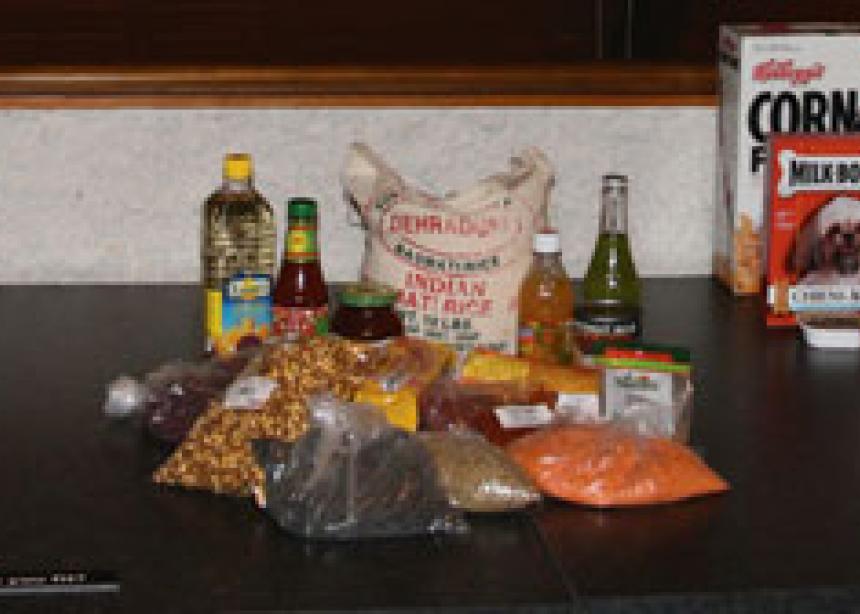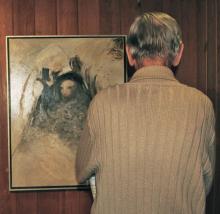The right to food is a non-issue for many Canadians. In fact, many people in the western world take food for granted.
From a faith perspective, many feel that, although they may not be hungry themselves, food systems are unjust when there is abundant food available to some while others go without.
Nineteen artists from 13 countries have come together to contribute to the Just Food: The Right to Food from a Faith Perspective art exhibit, and engage in a widely connected conversation about food justice. The exhibit is a project of the Mennonite Committee on Human Rights and is featured at the Mennonite Heritage Centre Gallery until Jan. 15. Previously, it was held in Steinbach, Man., at the Mennonite Heritage Village.
The exhibit is divided into six sections focusing on different areas of food justice, including a Bible passage and a human rights quote from the UN Declaration on Human Rights. Each section has contributions from local and international artists, some literal interpretations and others with more abstract interpretations.
The artists represent different cultural, economic and faith backgrounds.
Ovid Charlette explores literal interpre-tations through his paintings that he creates in his prison cell in the maximum-security unit of the Milner Ridge Correctional Centre, northeast of Winnipeg. He said that “To Them Who Are Without” and “Charity of the Sons,” both done in a traditional aboriginal style, reflect “people sharing with people who don’t have. Some tribes have abundance; some tribes are low in wildlife and are barren.” The paintings reflect on the human rights quote that states that everyone has the right to an adequate standard of living and on Amos 5:11-12, 14. Charlette is a Canadian, but food was an issue for him. He lived on the streets in Winnipeg since age 11, much of the time going hungry. Through his art, he hopes to build awareness of food justice.
For Bob Haverluck, a full-time artist in Winnipeg, art is his silent prayer. “The exhibit, to me, is an invitation to join in prayer,” he said.
Annelies Soomers, an issue-driven artist and a self-proclaimed “new Mennonite” visiting from the Netherlands, attended the opening on Nov. 20 and expressed her excitement to be a part of an exhibit that emphasizes the connection between faith, words and action. Her contributions, including “Daily Bread: From Plague to Blessing” and “Pour Down Righteousness,” evoke themes of western people who deflower the earth like locusts.
Soomers reflected on the global hope of formulating trade policies that serve the rights of people groups to food and to safe food production, as well as Leviticus 19:9-10 and Deuteronomy 24:19-21. “The poor pay the price for our wealth,” she said. “We can take action by changing our way of life.”
The exhibit also featured displays of differences in global eating patterns and a participatory display where viewers could respond to the exhibit by sharing what their response to the art would be: to do more about food justice, to learn more or to do nothing differently.
According to Paul Hagerman, a manager of public policy at the Canadian Foodgrains Bank and a speaker at the opening, “Just Food reaches a whole new audience. It is a whole new way to express food injustice.”
Art reaches a wider audience than a lecture or a conference, gallery curator Ray Dirks said. “What we’re trying to do here is provoke discussion. Obviously, we’re not going to provoke some people, but hopefully it’s in their heads and it does one day.”
Just Food sponsors include Mennonite Central Committee Canada, the Canadian Foodgrains Bank, the Canadian International Development Agency and the Ecumenical Advocacy Alliance.




Add new comment
Canadian Mennonite invites comments and encourages constructive discussion about our content. Actual full names (first and last) are required. Comments are moderated and may be edited. They will not appear online until approved and will be posted during business hours. Some comments may be reproduced in print.